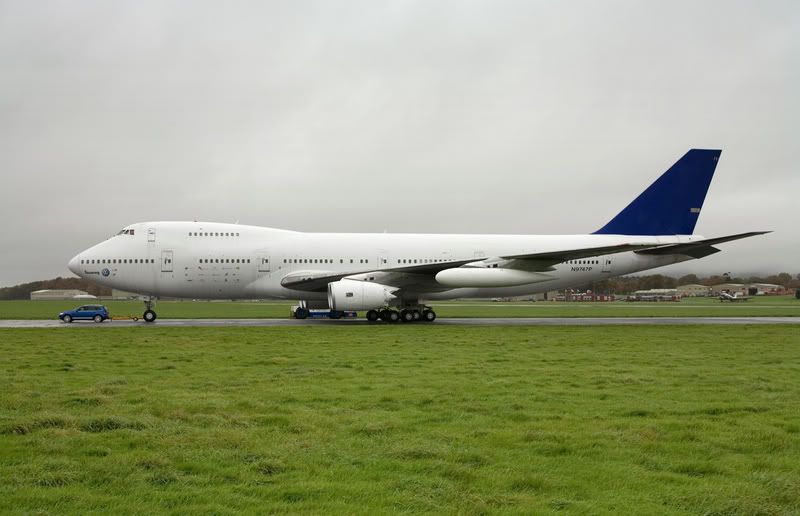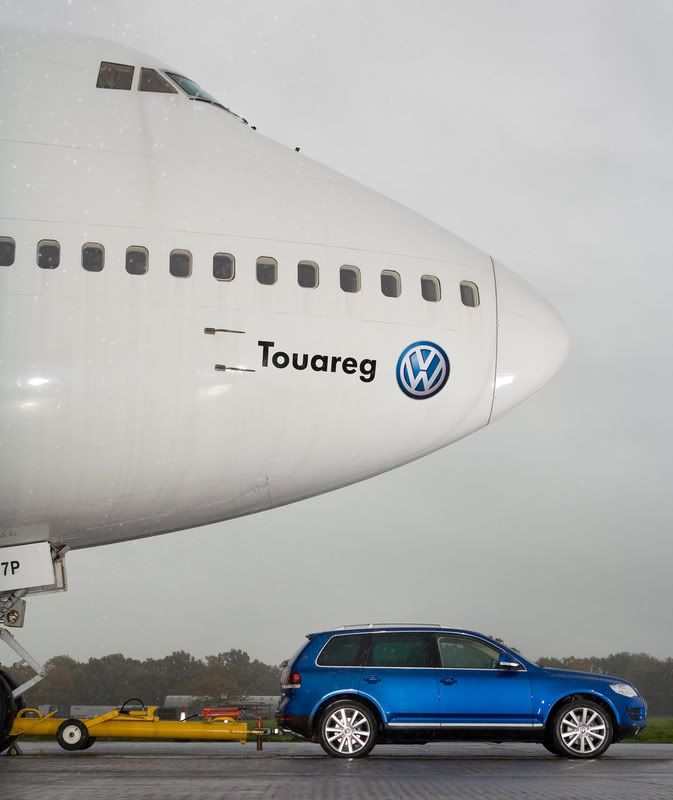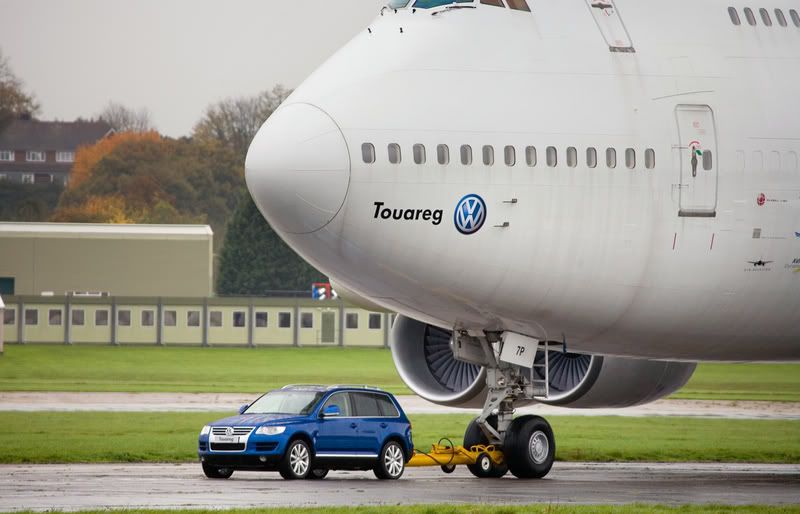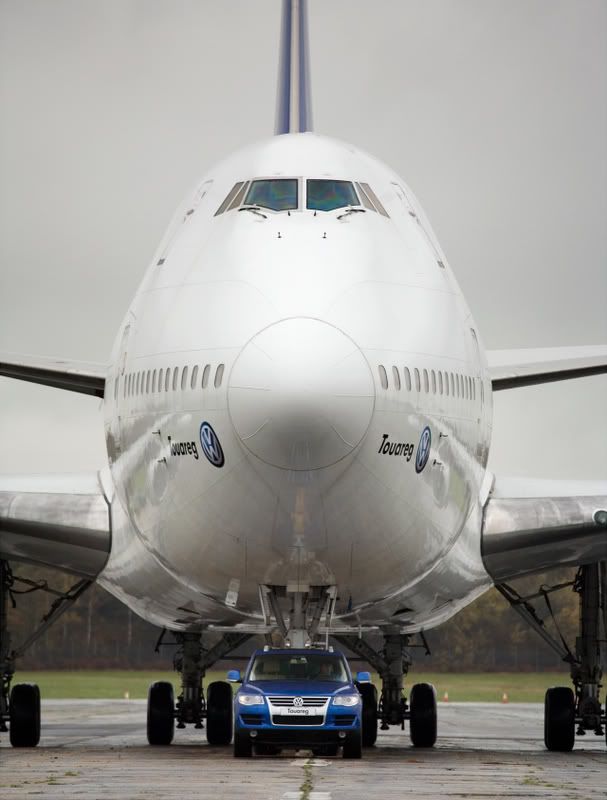Volkswagen shows what the Touareg can really do
Posted by Lorenzo at 10:09 pm
 Forget that trailer. Volkswagen says you should tow bigger stuff with your diesel-powered Touareg like, say, a Boeing 747-200. They did just that in a recent press event where Volkswagen wanted to demonstrate the Touareg V10 TDI's pulling power.
Forget that trailer. Volkswagen says you should tow bigger stuff with your diesel-powered Touareg like, say, a Boeing 747-200. They did just that in a recent press event where Volkswagen wanted to demonstrate the Touareg V10 TDI's pulling power.For all intents and purposes, this Touareg remained stock for this exercise. The only modifications were an axle from the Touareg V8 and towing gear to get the 747 on the Touareg's tail. The Touareg V8's axle turned out to unnecessary since the driver, Uwe Krieghoff, used low ratio second gear during the run. As well, ballast weights that totalled 4,345 kg were added to the Touareg bringing it's weight to 7,030 kg. Other than those additions, however, the Touareg sported a stock engine, transmission, suspension, tires, and brakes. The plane, on the other hand, was a decommissioned British Airways jet that is now used as props for movies. That meant it didn't have proper engines. However, weights on the aircraft compensated for this missing weight.
And indeed the Touareg got far, all things considered. About 150 meters at 5 mph until the Touareg stopped both itself and the plane with only the stock brakes. After the drive, Krieghoff said: "I was a bit disappointed we couldn't find something heavier to tow – it was too easy! If anyone can lend us a heavier aeroplane, please let us know." Indeed, when the Touareg was checked after the run, no adverse effects were found.
Press release and more photos of this unbelievable feat after the jump.
Source: Volkswagen AG


 Wolfsburg, 24 November 2006 - “Wanna bet that a Touareg V10 TDI can tow a Boeing 747?” “A 155-ton jet?” “Never!” “Sure it can!” This verbal exchange by two Volkswagen employees had consequences: A few months later, on Thursday this week, a Volkswagen crew did indeed hook up a new generation Touareg V10 TDI to a 747. The certified result: The SUV pulled it off easily. However, the receipt of orders from airport operators wanting to replace their tow vehicles weighing up to 70 tons with the significantly more economical Touareg could not be confirmed.
Wolfsburg, 24 November 2006 - “Wanna bet that a Touareg V10 TDI can tow a Boeing 747?” “A 155-ton jet?” “Never!” “Sure it can!” This verbal exchange by two Volkswagen employees had consequences: A few months later, on Thursday this week, a Volkswagen crew did indeed hook up a new generation Touareg V10 TDI to a 747. The certified result: The SUV pulled it off easily. However, the receipt of orders from airport operators wanting to replace their tow vehicles weighing up to 70 tons with the significantly more economical Touareg could not be confirmed.The "Touareg tows a Boeing 747" event took place at the Dunsfold Aerodrome in England, located 40 miles from the gates of London. From the very start the question, entirely seriously meant, was posed about how powerful a modern, top range SUV with engine, four-wheel drive and chassis is.
The Touareg is innately the ideal towing vehicle: Maximum load capacities are 3,500 kilos for trailers and 1,640 kilos for the rear axle. But when instead of a 3.5 ton boat trailer a jet weighing over 155 tons – consisting of 511 m2 of wing surface, 4 engines, 450 seats and a fuselage the size of a block of houses – is attached to the hitch, things look quite a bit different. Careful preparations must be made.
In order for the Touareg V10 TDI to be able to tow the big bird, the weight of the Volkswagen had to first be increased. This sounds paradoxical but is absolutely necessary so that the power of the engine can be converted into propelling force. For this purpose steel balls and steel plates were distributed in the SUV. Extra weight: 4,345 kilos! Total weight of the Touareg: 7,030 kilos. Weight distribution: 2,755 kilos in front, 4,275 kilos in back.
The other modifications were kept to a minimum. For the front axle drive the shorter transmission of the Touareg V8 was integrated in place of the V10 TDI transmission. The crew increased air pressure in the standard Michelin tires to 4.5 bar. And finally, the maximum speed was limited – not out of fear that the unusual harnessed system would become airborne, but to protect the tires. Everything else, from the engine to the shock suspension system and four-wheel drive corresponded exactly to the series production version.
An extra device was then used to hook up the Boeing 747 to the Touareg’s standard trailer hitch. The experiment could begin. Based on the maximum torque of the V10 TDI (750 Nm) and the transmission ratio, the engineers had previously calculated that the Touareg would be able to put approx. 200 tons into motion. But who would trust his calculations if a 1.7 meter high, 4.75 meter long car was suddenly attached to a 19.4 meter high jet over 70 meters long? Nobody would. Especially not when typical English weather with heavy rain and headwinds were lashing across the car and jet as if there was no tomorrow.
But the Touareg did the job. Volkswagen technician Uwe Krieghoff took the wheel. He started the engine. Using the four-wheel drive control on the middle console he selected the "LOW" setting for reduced off-road speed. 50 percent of driving force was now distributed to the front axle and 50 percent to the back. Krieghoff manually selected the second gear of the automatic transmission, accelerated slowly and reflected on getting the 18 head-height wheels of the 155 ton 747 rolling from a standing position. The greatest power was required in these few seconds. As soon as this harnessed system got moving, it would move. But the only thing that budged at first was the engine speed. Krieghoff continued to push down the gas pedal to about the halfway position. And with not a hint of traction problems the Touareg and the jumbo jet started moving. After a distance of 150 meters Krieghoff slowed the harnessed system to a stop.
A post check-up of the Touareg did not find any evidence of damage to the car. Everything was A-OK.
Incidentally, the new generation of the Touareg is now available for order. The SUV comes standard equipped with ESP plus trailer stabilization. It is extremely effective at preventing trailers from dangerously fishtailing when improperly loaded or traveling at excessively high speed. The system didn’t kick in during the test with the 747 – the speed was only eight km/h.











<< Home